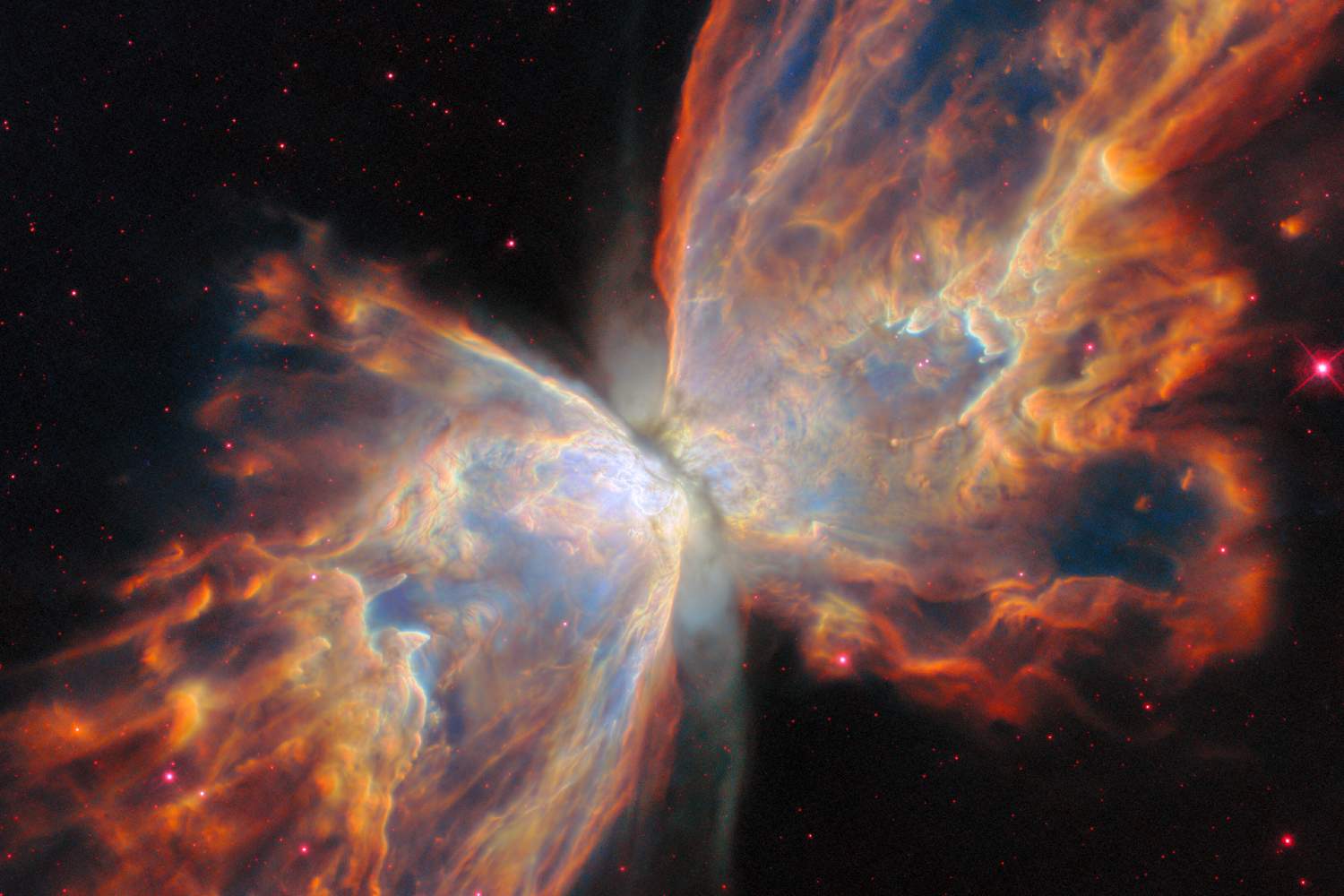The James Webb Space Telescope (JWST) has unveiled unprecedented details of one of the galaxy’s most spectacular stellar phenomena, revealing the hidden heart of the Butterfly Nebula for the first time.
Located 3,400 light-years away in the constellation Scorpius, the famous Butterfly Nebula has captivated astronomers with its distinctive wing-like structure.
However, its ancient central star in the very last throes of its life, remained hidden behind the thick dust of the butterfly’s ‘body’ until now.
Blazing central star
Previous searches lacked the resolution necessary to spot the tiny yet bright star which lights up the butterfly’s gas and dust ‘wings’.
Now the Mid-InfraRed Instrument (MIRI), on board the JWST, has penetrated dense cosmic dust to expose a blazing central star burning at almost 220,000°C.
This is one of the hottest known central stars powering a planetary nebula in our galaxy.
A distinctive nebula
As it is so hot, the star lights up the beautiful butterfly-like shape which makes this nebula so distinctive.
This is due to its multilayered structure, with heavily ionised atoms, requiring large amounts of energy, concentrated near the core, while atoms that need less energy are found in the outer regions.
A joint NASA, European Space Agency (ESA) and Canadian Space Agency (CSA) mission, JWST is the most powerful telescope ever sent into space.
The UK Astronomy Technology Centre (UK ATC) in Edinburgh played a key role in designing and building MIRI’s spectrometer that was used to peer through this cosmic veil.
Amazing detail
The Butterfly Nebula exemplifies planetary nebulae, stunning cosmic formations created when dying stars shed their outer layers.
Despite their name, these structures have nothing to do with planets, earning their title from early astronomers who thought they appeared planet-like through telescopes.
JWST has zoomed in on the centre of the Butterfly Nebula providing a detailed view of its complex structure.
Capturing the torus
This has allowed astronomers to study the core of its dusty torus, a doughnut-shaped structure, composed of gas and dust, which creates the bipolar flows of the butterfly’s ‘wings’.
MIRI and ALMA image of the centre of the Butterfly Nebula. Credit: ESA and JWST (N. Hirano, M. Zamani), NASA, CSA, M. Matsuura, ALMA (European Southern Observatory, National Astronomical Observatory of Japan, National Radio Astronomy Observatory)
The new image uses data from MIRI working in integral field unit mode.
This mode combines a camera and a spectrograph to take images at many different wavelengths simultaneously, revealing how an object’s appearance and structure changes with wavelength.
Complex structure
The nebula’s central star is in the process of dying, providing new insights into what may happen to our own sun at the end of its life.
MIRI identified nearly 200 distinct spectral lines, each revealing different chemical elements within the nebula’s complex structure.
Different elements
These observations show crystalline silicates like quartz forming the dusty torus, alongside iron and nickel jets blasting outward from the central star.
MIRI’s exceptional sensitivity has also detected polycyclic aromatic hydrocarbons, complex organic molecules, similar to soot on Earth, that may be forming as stellar winds interact with surrounding gas.
This represents the first evidence of such molecules developing within a planetary nebula.
Dynamic nebula
Research in this new paper published by the Royal Astronomical Society was partially funded by the Science and Technology Facilities Council (STFC).
Dr Mikako Matsuura at Cardiff University’s School of Physics and Astronomy and lead author on the paper, said:
We were surprised at just how dynamic the nebula is. The typical assumption is that planetary nebulae exist in a state of inactivity, a sort of resting phase for material which was ejected before the star became this shiny butterfly-like nebula.
Instead, we see what resemble both cool gemstones formed in calm, long-lasting zones and fiery grime created in violent, fast-moving parts of space, all within a single object.
Stellar evolution
Dr Olivia Jones, STFC JWST Fellow at UK ATC and co-author on the paper, said:
MIRI has opened up new areas of research and discovery. The 220,000 Kelvin temperature we’ve measured makes this one of the hottest stellar cores ever discovered in our galaxy.
These extreme temperatures illuminate the surrounding gas, which is why the Butterfly Nebula looks so spectacular. This finding transforms our understanding of how the most extreme stellar environments evolve.
MIRI Consortium
UK ATC led the MIRI European Consortium, who designed, built and tested MIRI.
MIRI was one of four scientific instruments on board the JWST.
This was in partnership with NASA Jet Propulsion Laboratory and The University of Arizona, backed by UK government funding via STFC and the UK Space Agency.
Power of international collaboration
UK ATC’s Professor Gillian Wright, who as Principal Investigator led the European team on MIRI, said:
This new research is a testament to the power of international collaboration and cutting-edge instrumentation.
MIRI’s capabilities are allowing us to peer into the heart of stellar evolution with unprecedented clarity. Discoveries like this are exactly why we built the instrument.
The research combines JWST observations with data from the Atacama Large Millimetre Array (ALMA), demonstrating how collaborative international science projects leverage technological expertise to unlock the mysteries of the Universe.



